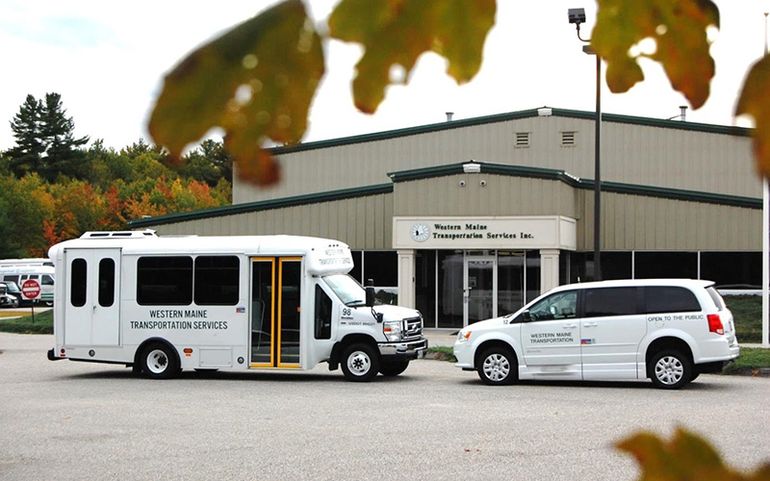Bus route creates new transportation options in western Maine
 Courtesy / Western Maine Transportation Services
Western Maine Transportation Services in Auburn will begin a once-a-month route from Rangeley to Farmington in Franklin County on Tuesday, a small piece of a transportation plan that is coming together following a study of the region's needs that was released in August.
Courtesy / Western Maine Transportation Services
Western Maine Transportation Services in Auburn will begin a once-a-month route from Rangeley to Farmington in Franklin County on Tuesday, a small piece of a transportation plan that is coming together following a study of the region's needs that was released in August.
At first glance, the new Farmington-Rangeley bus route, which begins Tuesday, may not seem like very big news. The 12-passenger bus will run on the second Tuesday of the month, stopping in Phillips and Strong as it makes its way along Route 4 through the heart of western Maine’s Franklin County.
But the route is the start of what Western Maine Transportation Services hopes will be a new approach to public transportation that would help shore up the region’s — and the state’s — economy.
The new route comes after a study commissioned by the Auburn-based company, which provides public and social service transportation to Androscoggin, Franklin and Oxford counties. The study was funded by a grant from the Maine Department of Transportation. Released in August, it assesses the transportation needs of the region and how those needs can be met. It was conducted by AECOM, an engineering consulting firm that worked with other consultants.
Western Maine Transportation Services, which also acquired the Brunswick Explorer in April 2016, is funded by federal, state, county and municipal governments as well as nonprofit and business partners. It provides services ranging from seasonal shuttles and fixed routes to Americans with Disability Act services.
“So many people see [public transportation] as a social service, rather than part of the infrastructure,” said Craig Zurhorst, community relations director of Western Maine Transportation. “That’s one of the mindsets that has to change.”
He said the study supported many of the conclusions that WMTS had already drawn about area transportation needs. “There’s a pretty sizable pent-up demand,” he said.
Getting workers to jobs
The Rangeley-Farmington route isn’t the only new service that came out of the study. The Sugarloaf Express begins Saturday and will run seven days a week from Farmington 40 miles up Route 27 to help address a worker shortage at the resort.
The service, in conjunction with the ski resort and the town of Carrabassett Valley, is separate from the Sugarloaf Explorer, a popular seasonal shuttle for skiers.
“If our projections are correct, it’s going to run close to capacity,” Zurhorst said.
Finding ways to get workers to jobs are was a major goal of the study. Others were connecting transit routes and services, addressing social services and finding ways to pay for it as federal and state funding decreases.
The routes that were ranked highest for potential use among the study’s responders were Lewiston-Auburn to Brunswick through Lisbon and Topsham, and to Bath; Wilton to Farmington; as well as Lewiston-Auburn to Wilton, to Farmington and to Bethel.
Rangeley-to-Farmington
The new Rangeley-to-Farmington route was not ranked high in the study, but it was one for which the pieces fell quickly into place. Zurhorst said it is low cost because it uses smaller buses and doesn’t run frequently.
Another factor is that Rangeley is the focus of a Thriving in Place grant awarded to Franklin County Elders in Action, under the umbrella of SeniorsPlus. The $273,153 planning grant from the Maine Health Access Foundation is being used to explore ways to make the town more accessible for its seniors. A small part of the grant was used to help with the study and planning.
The route will be a “big boost” to that cause, said Holly Zielinski, director of nutrition and community services for SeniorsPlus.
“Transportation is such an important piece in older adults maintaining their independence and preventing social isolation,” she said. “This service will allow them to plan their shopping trips, medical appointments, or even go out to lunch or a movie with friends.”
The Rangeley route is a flex route — it follows a route and schedule, but has time built in to go off route to make a requested stop. In the past few years, service in Franklin County had changed to a demand-response model that fit better with MaineCare requirements-- riders would call for a ride and get picked up.
But people wanted the flex routes, Zurhorst said. “All that time we didn’t have them, people have continued to ask when we were going to get it back.”
He said the transit service moving back to flex service will meet more community needs.
“We’ve pulled back on what seems to be the social services model to better serve the general public, but it doesn’t hurt the social services model,” he said.
Paying for it
One issue that makes change difficult is money. Federal funding has decreased and the state contributes less than a dollar per capita to public transportation, one of the lowest rates in the nation, Zurhorst said.
Local funding is tough as well. The Franklin County budget passed in June allots $7,500 to WMTS instead of the $10,500 requested.
While rural public transportation is inherently more expensive per unit served, he asked, “Does that mean it shouldn’t be funded?”
Advocates of public transit point out big picture benefits. The National Conference of State Legislatures in a 2015 report on state public transit funding noted studies have found access to transportation, particularly for jobs, had a stronger impact than any other factor on children rising out of poverty.
Franklin County, with a population of 30,000, has a 15.8% poverty rate, compared to the state’s 12.9%.
Zurhorst said it isn’t only lack of a car that’s an issue, but many people who do have a car may not have a reliable one. Some drivers aren’t comfortable driving in bad weather.
At the other end of the spectrum, younger people may not be able to afford a car or have access to one. “It severely limits their education and work opportunities,” he said.
The WMTS study lists more than 20 possible funding solutions for increased transit in the region, including fees, taxes, business solutions and other partnerships. Many of the solutions require legislative action.
Zurhorst said there’s a paradigm shift in the country, and even parts of Maine, about where public transportation fits into a sustainable economy.
While that shift has yet to reach rural Maine, he said those who believe in it are making it happen. “One thing to note is how hard all transportation providers are working to make it reliable and sustainable.”
“We’re looking at the seeds, it’s just germinating now,” he said. He said the Rangeley bus route and Sugarloaf Express are two small pieces. “I hope it spurs awareness of what we do.”










Comments